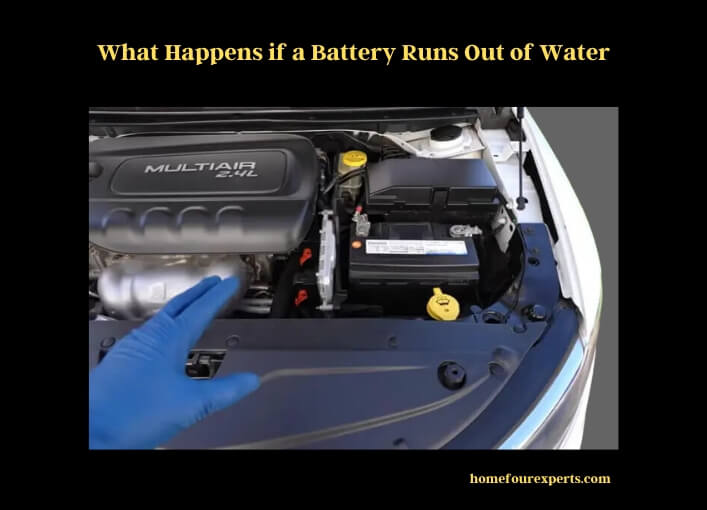When it comes to batteries, car owners are well-acquainted with the difficulty of dealing with them. Watering a battery may sound simple, but it’s actually pretty difficult. But what happens if a battery runs out of water? How do you know if a battery needs water? The first thing you need to know is why the battery is leaking water. An overcharging, sulfation, temperature increase, or a change in the climate could all play a role in this.
Water isn’t necessary for all batteries to operate correctly. Lead-acid batteries are among the most widely used water-dependent batteries. They’re cost-effective, simple to maintain, and long-lasting.

If you see any of these indicators, don’t disregard your battery. Symptoms such as a slow or non-existent starter, dim lighting, flickering lights, various electrical difficulties, or even an illuminated check engine light point to a battery issue. After knowing the signs, you also must know how much-distilled water to add to a battery. Please read on for more information. Stay with us by reading the additional information on what happens if the water in a battery goes low or runs out completely.
Battery Water: What Is It?
The term ‘electrolyte’ refers to the liquid solution that makes up your flooded lead-acid battery. Batteries charge devices or cars using this liquid. Is battery water the same as electrolyte solution? No. In your battery, the electrolyte is a sulfuric acid and water solution. Battery water, on the other hand, is the water that is used to refill the electrolyte when it runs low.
Typically, battery water is distilled or deionized water. As tap water may contain pollutants, it’s wise to never use taps water. [amazon link=”B08374YFYN” title=”HAVENLAB Deionized Water” /] removes all ions, minerals, and heavily charged impurities that extend the battery life. If you want to save a buck then you can make distilled water for batteries at home easily.
What Is Battery Electrolyte?
Rechargeable batteries rely heavily on electrolytes for their power generation. This is how it works:
- Flat lead plates are submerged in an electrolyte solution in your battery;
- The electrolyte warms up as soon as the battery is being charged;
- Hydrogen gas and oxygen gas are released via the battery’s vents due to the charge breaking down water;
- Chemical reactions between the two lead plates are triggered by the battery fluid’s sulphuric acid.
The Function of Battery Water
All marine, automotive, solar and industrial lead-acid batteries are dependent on battery water for smooth operation. The electrolyte solution in your flooded battery helps it function. Evaporation occurs in the battery electrolyte every time it is charged, which heats the electrolyte solution, and this affects the battery’s water density and also raises the sulfuric acid concentration.
Leaving the extra sulfuric acid in the battery will eventually lead to sulfation and irreversible damage. It’s at this point that battery water comes into play. To avoid low electrolyte levels and to maintain the acid content in the electrolyte solution, purified water must be added.
What Causes a Battery Runs Out of Water?
Electrolytic concentration rises when water is introduced to a lithium-ion battery. Electrolytic levels decline due to a decrease in water volume in a battery running low on water. So what happens if a Car Battery runs out of water? Actually, they all react in the same manner. Before comprehending the consequences, you must first know why a battery runs out of water. The following is a list of all of the reasons why:
Excessive Charging
Expired water is the most typical cause of a battery going dead. Electrolytic levels rise abnormally when a battery is overcharged because an excess of electricity is stored in it. Allowing the battery to sit for a time and then perform the same procedure again is easy.
Temperature
The amount of water that evaporates from the battery is greatly influenced by the temperature of the battery. That’s because the surrounding environment greatly influences the battery’s capacity. In cold weather, battery capacity decreases, and vice versa. Premature aging and water dissolution in the battery are two possible outcomes.
Decreased Usage
Another factor contributing to water loss is decreased usage, particularly in cars. The battery assumes no activity and self-deactivates as soon as a car is left inactive for an extended period. It’s also possible that the battery will lose water as a result.
Charger for a Battery
An incorrect battery charger might also cause water loss, and batteries might suffer from an over-or under-voltage condition. A few hours later, your battery may have been destroyed due to water dissolving.
Underwatering
Underwatering occurs when a battery’s electrolyte level drops too low. Each time you charge your battery, it loses more water. Sulfation occurs when the lead plates of a battery are exposed to oxygen and hydrogen gas for an extended period of time. Here’s how to avoid it:
- Never use tap water; always clean or deionized;
- Always charge your batteries fully. A forklift or Golf cart battery requires more charging than a deep cycle battery;
- Adapt the charging frequency;
- Never leave your lead-acid batteries uncharged. They can sulphate if not recharged frequently.
- Batteries lose water as they are charged. Remember to keep them topped up.
Over-watering
Overwatering occurs when you add too much battery fluid to your electrolyte solution. Overwatering can severely damage the battery cell and reduce performance. Overwatering causes two issues:
- Dilution of electrolyte solution will occur first. This reduces battery performance as it lacks charge.
- Second, watering the battery before charging it causes it to overheat. Because the liquid expands when the battery charges, the battery acid will spill out if it is too small.
How to Check Battery’s Electrolyte Levels?
Rechargeable batteries always have three distinct amounts of electrolyte. It’s the following:
Low:
Are you searching for the answer: What happens if battery water is too low? Low electrolyte solutions reveal the lead plates in this case, indicating the water is needed if the plates aren’t submerged.
Normal:
At this point, the electrolyte is roughly 1cm higher than the lead plates. Add no additional water at this time.
Maximum:
This indicates that the fluid level in the filler tubes is approaching its lowest point. You should stop before this point if you can.
Which Water Should Be Used in a Battery?
You already know what happens if a lead-acid battery runs out of water. Now you must choose the water wisely to put in the battery. It is wise not to use tap water in the battery, and regular tap water won’t recharge your battery. Even modest amounts of tap water include minerals that degrade batteries, especially true for chloride-based water softeners. Distilled water is the safest option and costs far less than a new battery. In that case,
[amazon link=”B0881Y1PS4″ title=”Deionized Prime Demineralized Solution water” /] is an ideal choice to get the long-term efficiency of the battery.
Remember that water will lie on top of your battery’s acid solution until it is stirred by charging bubbles. Take [amazon link=”B07BL1789H” title=”electrolyte hydrometer” /] measurements when charging is complete. Don’t let your battery dry out, and try to keep it moist all year.
How to Water a Battery?
It is important to check the water level before charging a battery to ensure that all exposed plates are covered with enough fluid. After charging, pour water to the bottom of the vent until the level is 34 below the cell’s top. For better mess-free pouring you can use [amazon link=”B003EHIFE4″ title=” Performance Tool W54274 Battery Filler” /].
There should be no sulfuric acid in a battery at any point in its life, and batteries consume only water and not sulfuric acid during regular operation. If the electrolyte level is low, refilling your battery with water will keep your battery in good working order.
FAQs
1. Is a Battery Ruined if It Runs Out of Water?
Underwatering occurs when a battery’s electrolyte level drops too low. Each time you charge your battery, it loses more water. Sulfation occurs when the battery’s lead plates are exposed to oxygen and hydrogen gas, which may permanently damage the battery.
2. Why Would My Car Battery Be Losing Water?
Unless you keep your car battery properly hydrated, the electrolyte will get imbalanced and the batteries will become acidic, which will cause sulphation on the battery plates if the water level is too low.
3. How Do You Revive a Dry Battery?
First, let your old lead-acid batteries charge for around a week to 10 days to get the most out of your battery. De-sulphation is dissolved by charging very lowly, reviving the battery’s capacity back into usable range.
4. What Happens if Golf Cart Batteries Run Out of Water?
The plates in your golf cart battery will begin to flake off if the water level in the battery is allowed to drop too low. As a result, you’ll be unable to use your golf cart and must purchase a new battery altogether.
5. Is It Possible to Put Water in a Dry Battery?
Yes, Dry battery cells can be filled with water. If the electrolyte boils down, it must be diluted, but do not use tap water! Salts and solids can damage a battery in tap water.
Final Verdict
As the battery ages, it will inevitably begin to fail. After reading this piece of writing, I hope you now know what happens if a battery runs out of water, and you will regularly follow up on your battery conditions.
Maintaining the health of your battery is as simple as making regular trips to the store and having it checked out at an interval. Your wallet, too, as a battery owner, will be grateful then!
Read more:
About This Writer

Hi, I am responsible for the 'Homeowners Power Solutions' category. My name is Liam Jaxon and a licensed technician with 7 years of experience in vehicle batteries, electrical gadgets, and home appliances. My working experience in different residential & light commercial electrical sectors and the automobile industry helped to acquire vast knowledge in this industry.